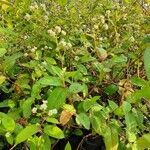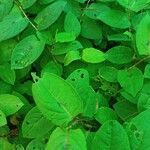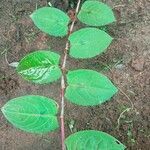Plants perennial, 7-10 dm; roots not also arising from proximal nodes; rhizomes present. Stems ascending to erect, sometimes scandent, glabrous or retrorsely hispid. Leaves: ocrea brownish, cylindric, 15-25(-50) mm, coriaceous proximally, chartaceous distally, base often inflated, margins oblique, eciliate, surface glabrous or pubescent; petiole 1-2.5 cm, winged at least distally; blade lanceolate to ovate or elliptic, 4-16 × 1.5-8 cm, base truncate to broadly cordate, margins glabrous or antrorsely scabrous with whitish hairs, apex acuminate, faces glabrous or hispid abaxially and adaxially, sometimes pubescent only along veins abaxially, not glandular-punctate but often minutely reddish-punctate abaxially. Inflorescences terminal or terminal and axillary, 3-6 × 3-6 mm; peduncle 10-30 mm, stipitate-glandular along entire length; ocreolae overlapping, margins eciliate. Pedicels mostly ascending, 2-3 mm. Flowers 1-3 per ocreate fascicle; perianth white to pink, campanulate, glabrous, accrescent; tepals 5, ovate, 3-4 mm, apex acute to obtuse; stamens 8, filaments distinct, free; anthers red or purple, elliptic; styles 3, connate proximally. Achenes included in fleshy, bluish black perianth, black, 3-gonous, 2.8-4 × 2-3 mm, dull, minutely punctuate.
More
A herb. It is a straggling perennial weed often woody near the base and up to 2-3 m tall. It can be a climber. Branches are ridged and grooved. Leaves are alternate and have stalks. The leaves are 2.5-14 cm long by 1.3-8 cm wide. They are oblong to sword shaped. They taper to the tip. They are hairy on the mid vein underneath. The base is cut off. Flowers are at the top and are white or pink. A black berry-like fruit develops with a 3 sided shape.
A tropical and subtropical plant. In Nepal it grows between 700-2200 m altitude. It grows in moist, open places. It grows in wetlands. It occurs in natural forest clearings and in abandoned gardens. It is mostly between 1000 m and 2500 m altitude. It occurs in the Western Ghats in India. In XTBG Yunnan.
More
Very common in brushwood, forest borders, open forest, riverbanks, and tea-and Cinchona-plantations; throughout Indo-China; at elevations from sea level to 3,300 metres. Damp wasteground in lowlands and mountains in Malesia.
Very common in brushwood, forest borders, open forest, riverbanks, and tea-and Cinchona-plantations; throughout Indo-China; at elevations from sea level to 3,300 metres. Damp wasteground in lowlands and mountains in Malesia.
The young leaves are eaten as a salad or condiment. The harvested leaves can be stored for 4-5 days. They are cooked and used as a vegetable. They are used in curries and chutney. The tender leaves and shoots are pickled. They are also eaten fresh. The flowers are acidic and are eaten raw. The small nutlets are also eaten. CAUTION Several Polygonums or smart weeds are considered poisonous for animals.







